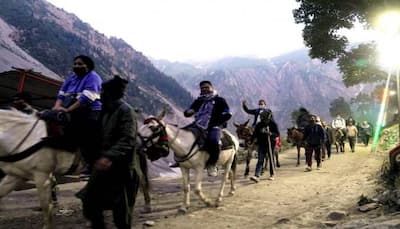Following the recent terror attack at Baisaran meadow in Jammu and Kashmir’s Pahalgam, the upcoming Amarnath Yatra, which is scheduled to begin from July 3, has become a focal point for security agencies across the Valley. Ensuring a peaceful and incident-free pilgrimage has become the top priority for both the government and security forces in the region.
Preparations are in full swing at the two primary base camps – Baltal in Sonamarg and Nunwan at Pahalgam in Anantnag. Unlike previous years when devotees stayed in temporary tents, this year, permanent structures are being constructed to provide improved lodging and comfort. These facilities are being completed at a rapid pace and work is continuing day and night to welcome thousands of pilgrims.
Officials anticipate a significant turnout this year, which they believe could mark a turning point for the revival of tourism in the Union Territory. The administration is optimistic that the yatra will not only reaffirm the region’s spiritual importance but also restore confidence in Kashmir’s safety and hospitality.
“The Yatra is beginning, and we are hopeful of meeting Bhole Nath. A lot of people will come. Once they return, they will tell others that Kashmir is peaceful and beautiful,” said Dr. Farooq Abdullah, president of the Jammu and Kashmir National Conference (JKNC).
All government departments have been coordinating closely to ensure smooth execution of the pilgrimage. Key areas of focus include security arrangements, traffic regulation, accommodation, sanitation, fire safety and yatra registration facilities.
To further bolster security, authorities have enhanced surveillance along the highways leading to the base camps in Anantnag and Ganderbal districts. In a major technological leap, the Jammu and Kashmir government is also setting up a digital Hi-Tech Command Control Centre to oversee real-time surveillance and regulation of the Yatra.
“Our constant effort is to ensure that the Yatra proceeds peacefully, and that pilgrims are able to complete their journey and return safely. That has always been our goal, and it will remain so,” said Chief Minister Omar Abdullah.
The Hi-Tech Command Control Centre will house around 60 personnel drawn from 20 different government departments, including the Jammu and Kashmir Police, the CRPF, the NDRF, the SDRF, Health, PHE, PDD, Telecom and others. These teams will work round-the-clock to respond swiftly to any situation that may arise.
The route from both base camps to the holy cave will be monitored using dozens of high-definition PTZ (pan-tilt-zoom) cameras offering 360-degree views. In addition, several static cameras will be strategically placed at critical locations to enhance security coverage.
In anticipation of natural calamities or emergencies, quick response teams from the J&K Police, the NDRF, the SDRF, the BSF and the CRPF will be stationed at important locations along the route. Their presence is meant to ensure immediate assistance to pilgrims in the event of any untoward incident.
All registered pilgrims will be provided with RFID (Radio Frequency Identification) tags, allowing authorities to track their movement in real-time and ensure their safety throughout the journey.
Stay informed on all the , real-time updates, and follow all the important headlines in and on Zee News.








